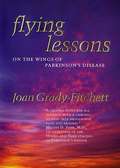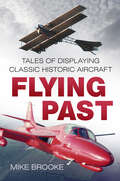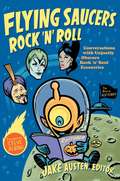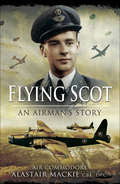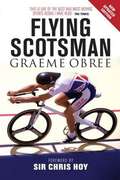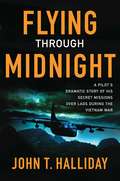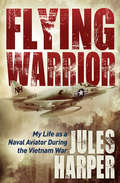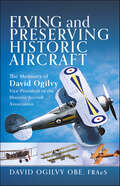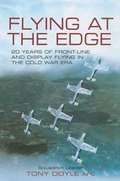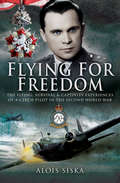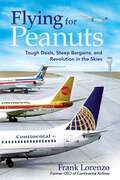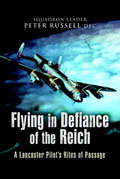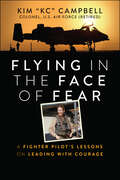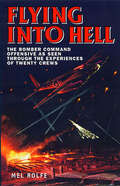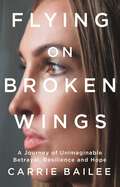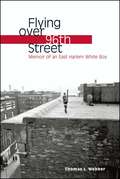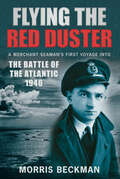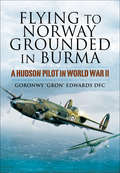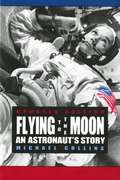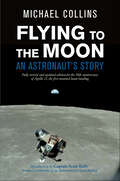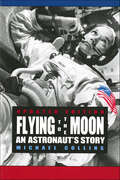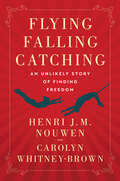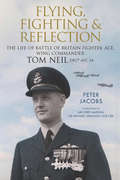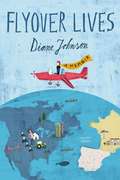- Table View
- List View
Flying Lessons: On the Wings of Parkinson's Disease
by Joan Grady-FitchettThe book is about a woman, Grady-Fitchett, who is suffering from Parkinson's disease and fighting against it. Her passion to be independent has been clearly described in this book.
Flying Past: Tales of Displaying Classic Historic Aircraft
by Mike BrookeFOLLOWING the four books describing his successful career as a military and civilian pilot, in Flying Past Mike Brooke gives the reader a fascinating insight into his experiences flying historic aircraft at airshows in the UK and Europe. From the highs to the lows he takes us through the feeling of flying a Spitfire, working with the Red Devils Parachute Team, flying with The Shuttleworth Collection and in the Harvard Formation Team, and the pressures put on display pilots – as well as the importance of preparation, discipline and safety. This entertaining and informative collection of stories will not only delight the many who have enjoyed Mike’s series of memoirs so far, but also appeal to anyone with an interest in classic historic aircraft, aerobatics and airshows.
Flying Saucers Rock 'n' Roll: Conversations with Unjustly Obscure Rock 'n' Soul Eccentrics
by Jake AustenFor nearly twenty years, the much-beloved music magazine Roctober has featured work by some of the best underground cartoonists, exhaustive examinations of made-up genres such as "robot rock," and an ongoing exploration of everything Sammy Davis Jr. ever sang, said, or did. But the heart of the magazine has always been the lengthy conversations with overlooked or forgotten artists. Flying Saucers Rock 'n' Roll gathers the most compelling of these interviews. Eccentric, important artists--including the rockabilly icon Billy Lee Riley, the jazz musician and activist Oscar Brown Jr. , the "Outlaw Country" singer David Allan Coe, and the pioneer rock 'n' roll group the Treniers--give the most in-depth interviews of their lengthy careers. Obscure musicians, such as the Armenian-language novelty artist Guy Chookoorian and the frustrated interstellar glam act Zolar X, reveal fascinating lives lived at rock's margins. Roctober's legendarily dedicated writers convey telling anecdotes in the fervent, captivating prose that has long been appreciated by music enthusiasts. Along with the entertaining interviews, Flying Saucers Rock 'n' Roll features more than sixty images from the pages of Roctober and ten illustrations created for the book by the underground rock 'n' roll artist King Merinuk. Contributors Steve Albini Ben Austen Jake Austen John Battles Bosco Ken Burke Mike Maltese King Merinuk Ken Mottet Jonathan Poletti James Porter "Colonel" Dan Sorenson Jacqueline Stewart
Flying Scot: An Airman’s Story
by Alastair Mackie"This is the memoir of a 26 year career in the RAF, told with humor and modesty that belies the danger of flying over 47 different types of military aircraft in war and peace. Alastair Mackie began his operational career flying Wellington bombers over the North African desert war until converting to the B-24 Liberator. He watched the famous opening barrage at the opening of El Alamein from the air and became involved in supplying the besieged island of Malta together with hunting German ships in the Mediterranean. He was then posted to Northern Ireland converting to the DC-3. He flew during D-Day, dropping parachute troops into German held territory and continued these operations until the wars end when he was part of the operation to return British troops and released POWs to the UK. He was then posted to a long-range DC-3 squadron and flew to all points East.After the war he was posted to The Central Flying School teaching future flying instructors in a variety of aircraft from Tiger Moths to Lancasters. After a tour in the Far East where he flew his own personal Spitfire, he returned to the UK to convert to the jet aircraft then coming into service. After a spell desk bound on the Cabinet Office Joint Intelligence Committee, which he disliked, he was appointed Station Commander at Colerne which operated the Hastings transport aircraft. Alastair was then appointed wing commander in charge of flying at RAF Waddington. The job also gave him the charge of two resident Canberra bomber squadrons, Nos. 37 and 38. With them he was able to get plenty of flying in an aircraft he loved. After retiring from the RAF he commenced a career in Law and in his later years he has become a firm opponent of Britains nuclear deterrent, having seen its preparation with the Vulcan Force until the Royal Navy assumed the role it now has. "
Flying Scotsman: The Graeme Obree Story (Velo Press Ser.)
by Graeme ObreeThe record-breaking cyclist shares his battle with bipolar disorder: &“One of the best and most moving sports books I have read&” (The Times). Number 10 on Cycle Sport's list of Best 50 Cycling Books of All Time On July 17, 1993, cyclist Graeme Obree stunned the world when he emerged from obscurity to smash Francesco Moser&’s World Hour Record. The Flying Scotsman is his searing autobiography, from his tough upbringing in Scotland, where he found escape on the roads, to his head-to-head duels with Chris Boardman and his rise to stardom on the European circuit. Obree created massive controversy in the professional cycling world with his unique riding style and his pioneering construction techniques—famously using washing-machine parts to complete the building of his &“Old Faithful.&” Yet all his sporting success was achieved in the shadow of mental illness and suicidal despair. In this book, he tells his amazing life story—with all its ups and downs. &“Hard-hitting and brutally honest.&” —Cycling Weekly
Flying Through Midnight: A Pilot's Dramatic Story of His Secret Missions Over Laos During the Vietnam War
by John T. HallidayRiveting, novelistic, and startlingly candid, John T. Halliday's combat memoir begins in 1970, when Halliday has just landed in the middle of the Vietnam War, primed to begin his assignment with the 606th Special Operations Squadron. But there's a catch: He's stationed in a kind of no-man's-land. No one on his base flies with ID, patches, or rank. Even as Richard Nixon firmly denies reporters' charges that the United States has forces in Laos, Halliday realizes that from his base in Thailand, he will be flying top-secret, black-ops night missions over the Laotian Ho Chi Minh Trail. A naive yet thoughtful twenty-four-year-old, Halliday was utterly unprepared for the horrors of war. On his first mission, Halliday's C-123 aircraft dodges more than a thousand antiaircraft shells, and that is just the beginning. Nothing is as he expected -- not the operations, not the way his shell-shocked fellow pilots look and act, and certainly not the squadron's daredevil, seat-of-one's-pants approach to piloting. But before long, Halliday has become one of those seasoned and shell-shocked pilots, and finds himself in a desperate search for a way to elude certain death. Using frank, true-to-life dialogue, potent imagery, and classic 1970s song lyrics, Halliday deftly describes the fraught Laotian skies and re-creates his struggle to navigate the frustrating Air Force bureaucracy, the deprivations of a remote base far from home and his young wife, and his fight to preserve his sanity. The resulting nonfiction narrative vividly captures not only the intricate, distorted culture of war but also the essence of the Vietnam veteran's experience of this troubled era. A powerhouse fusion of pathos and humor, brutal realism and intimate reflection, Flying Through Midnight is a landmark contribution to war literature, revealing previously top-secret intelligence on the 606th's night missions. Fast-paced, thrilling, and bitingly intelligent, Halliday illuminates it all: the heart-pounding air battles, the close friendships, the crippling fear, and the astonishing final escape that made the telling of it possible.
Flying Through Midnight: A Pilot's Dramatic Story of His Secret Missions over Laos During the Vietnam War
by John T. HallidayRiveting, novelistic, and startlingly candid, John T. Halliday's combat memoir begins in 1970, when Halliday has just landed in the middle of the Vietnam War, primed to begin his assignment with the 606th Special Operations Squadron. But there's a catch: He's stationed in a kind of no-man's-land. No one on his base flies with ID, patches, or rank. Even as Richard Nixon firmly denies reporters' charges that the United States has forces in Laos, Halliday realizes that from his base in Thailand, he will be flying top-secret, black-ops night missions over the Laotian Ho Chi Minh Trail. A naive yet thoughtful twenty-four-year-old, Halliday was utterly unprepared for the horrors of war. On his first mission, Halliday's C-123 aircraft dodges more than a thousand antiaircraft shells, and that is just the beginning. Nothing is as he expected -- not the operations, not the way his shell-shocked fellow pilots look and act, and certainly not the squadron's daredevil, seat-of-one's-pants approach to piloting. But before long, Halliday has become one of those seasoned and shell-shocked pilots, and finds himself in a desperate search for a way to elude certain death. Using frank, true-to-life dialogue, potent imagery, and classic 1970s song lyrics, Halliday deftly describes the fraught Laotian skies and re-creates his struggle to navigate the frustrating Air Force bureaucracy, the deprivations of a remote base far from home and his young wife, and his fight to preserve his sanity. The resulting nonfiction narrative vividly captures not only the intricate, distorted culture of war but also the essence of the Vietnam veteran's experience of this troubled era. A powerhouse fusion of pathos and humor, brutal realism and intimate reflection, Flying Through Midnight is a landmark contribution to war literature, revealing previously top-secret intelligence on the 606th's night missions. Fast-paced, thrilling, and bitingly intelligent, Halliday illuminates it all: the heart-pounding air battles, the close friendships, the crippling fear, and the astonishing final escape that made the telling of it possible.
Flying Warrior: My Life as a Naval Aviator During the Vietnam War
by Jules HarperA Vietnam veteran takes you into the cockpit and shares true stories of his flying career in this compelling memoir. In this action-packed memoir, Jules Harper recounts the unique process of becoming a naval aviator, revealing his experiences as a brand new pilot in a combat squadron and, finally, a flying warrior. He survived two combat cruises aboard the aircraft carrier USS Kitty Hawk from 1966–1968, compiled 332 career carrier takeoffs and landings, and was shot at daily by enemy fire while completing 200 combat missions over Vietnam, and shares the views of the aviators who flew along with him on these missions while fighting this unpopular war. A recipient of the Distinguished Flying Cross, twenty-one Air Medals, and many other accolades, he offers readers a new understanding and appreciation of the warriors who protect not only their comrades in arms, but the defense of the nation as well.
Flying and Preserving Historic Aircraft: The Memoirs of David Ogilvy OBE, Vice-President of the Historic Aircraft Association
by David Frederick OgilvyDavid Ogilvy has spent more than a full working life in aviation. As a schoolboy he was sent out with a bugle and binoculars to blow a warning if a V1 flying bomb appeared. Soon after this, he joined the Royal Air Force and served for six years as a pilot, flying types ranging from the Tiger Moth to the Mosquito and Meteor. As a civilian he spent fourteen years involved in pilot training and became Chief Instructor of the Air Schools group, with responsibility for three establishments. He was a keen display and racing pilot and competed in many events, flying several historic types. At an early age David realised the need for owners and operators of flyable pre-war machines to have a representative organization to look after their concerns and interests, so, in 1951, when 22 and still serving in the RAF, he was a co-founder of the Vintage Aeroplane Club. He was also a founding member, and now a Vice President, of the Historic Aircraft Association. In 1966 David was appointed general manager of the famous Shuttleworth Collection at Old Warden. During this time, he brought in several historic aircraft, including initiating the retrieval of a 1935 Hawker Hind from Afghanistan. He flew many of the Collection’s remarkable airplanes, organizing and participating in the displays. As well as outlining his remarkable career, the main focus of this book is on David Ogilvy's descriptions of many of the historic aircraft he helped rescue and preserve and what it was like to be at their controls. It therefore provides a unique compendium of the flying characteristics of a range of historic aircraft for one or two of which, he unashamedly admits, he is possibly the last man alive to have flown. Away from the cockpit, David has been associated with many organizations, including being a founder member of the UK Aircraft Owners and Pilots Association, serving for 45 years in the roles of editor, Executive Chairman and President. He is also President of today's Vintage Aircraft Club and is a Fellow of the Royal Aeronautical Society. David was awarded the OBE ‘for services to aviation’ in I996.
Flying at the Edge: 20 Years of Front-Line and Display Flying in the Cold War Era
by Tony DoyleA firsthand account of a twenty-year career as an RAF fighter pilot, instructor, aerobatic flyer, and squadron leader. Tony Doyle first flew in the CCF, where he completed a glider course and then a highly prized Flying Scholarship. This opened the way to joining the RAF and becoming an all-weather tactical fighter pilot flying de Havilland Vampires and Gloster Meteors. At this he excelled, and he was posted as a flying instructor and then Staff Instructor. This was the age when the Jet Provost was the standard training aircraft. In 1962, Doyle was selected to fly with the newly formed Red Pelicans aerobatic display team and honed his skills as a display pilot. He moved to RAF Valley as the new Folland Gnat was being introduced in the training role. This diminutive aircraft was somewhat of a breakthrough—and after several design problems were ironed out it proved a superb aircraft, fast and agile. The general public were eager to see this new RAF addition and Doyle became its display pilot, flying at open days throughout the UK and Europe. In 1964 he converted to the English Electric Lightning, Britain&’s one and only supersonic fighter, with a top speed in excess of Mach 2 and a ceiling of 50,000 feet. He was posted to Treble One Squadron at Wattisham in October 1964 as part of the Quick Reaction Alert force against potential Russian bomber attacks. Once again he became the Lightning&’s chosen low-level display pilot and demonstrated it at the 1965 Paris Air Show. Shortly after that, he was forced to eject over the North Cornish coast after an engine explosion caused the loss of elevator control. This fascinating account of front-line and display flying goes into considerable detail of the aerodynamic qualities, dangers, and advantages of the types flown—and recounts life-threatening incidents and successes that will educate anyone interested in flying at the very edge.
Flying for Freedom: The Flying, Survival and Captivity Experiences of a Czech Pilot in the Second World War
by Alois SiskaAlois Siska was born in Czechoslovakia and learnt to fly. He escaped to the UK after the German invasion and joined the R.A.F. He describes his experiences flying Wellington bombers. In December 1943 he was shot down and he and surviving members of the crew were adrift in the North Sea for 7 days in appalling conditions. Picked up by the Germans he underwent surgery to his badly wounded legs and became a POW. He suffered at the hands of the Gestapo and was held in numerous camps including Colditz. His injuries were so extensive that he was put under the care of Archibald McIndoe. Siska chose to return to his native country to join their air force but fell foul of the Communist authorities. His persecution is described in the closing chapters. His rank was restored only in 1991 on the collapse of the Communist regime. Despite his injuries he remained active until 2003 when he died just short of his 90th birthday. He was as an active member of the Czech Ex-R.A.F. Association, the R.A.F. Benevolent Fund in his country, and the Sue Ryder Homes for which he raised considerable funds. His death was marked with a fly-past of the Czech Air Force and he was posthumously awarded the highest military decoration—The Order of the White Lion.
Flying for Peanuts: Tough Deals, Steep Bargains, and Revolution in the Skies
by Frank LorenzoLessons in business and life from the executive who helped shape the modern airline industry Frank Lorenzo is the epitome of the American dream. A first-generation American and entrepreneur, Lorenzo started an airline advisory business in his mid-twenties based on little more than bravado and ultimately rose to control the largest fleet of airplanes in the free world. Flying for Peanuts recounts how Lorenzo grew his empire from nothing and helped shape the airline industry as we know it.Flying for Peanuts explains how the son of Spanish immigrants put himself through Columbia College by driving a Coca-Cola truck and then grew the fledgling advisory into ownership of Texas International Airlines. At TIA, he fought through the industry&’s transformation, in part by introducing the new, low-cost model for fares that are a major part of the industry today. From there, through a series of shrewd moves and a hostile takeover, Lorenzo became CEO of Continental Airlines, a large loss-making west coast airline at the time. This airline business memoir gives a play-by-play of the high-stakes negotiations that got Lorenzo there, including faceoffs with Carl Icahn and a chapter devoted to selling the Eastern Airlines Shuttle to Donald Trump, soon to become the doomed Trump Shuttle. It details Lorenzo&’s competition with upstarts like Southwest Airlines and the clashes with unions that led Fortune&’s to name him one of &“America&’s toughest bosses,&” along with accolades from his employees. Along the way, Lorenzo highlights the strategies and tactics that propelled his growth.Flying for Peanuts is a compelling read for anyone interested in the American airline industry and anyone wanting to apply a trailblazing executive&’s lessons for their own career success.
Flying in Defiance of the Reich: A Lancaster Pilot's Rites of Passage
by Peter RussellThis is the vivid memoir of a man who was twenty-one at the outbreak of World War II. Having joined the RAFVR before the war, he was mobilized in August 1939 and after training became operational on 233 Squadron Coastal Command flying Hudsons from Leuchars, Aldergrove and St Eval. After fourteen months he was rested and was tasked with training navigators for the impending enlargement of Bomber Command.In 1944 he joined 625 Squadron flying Lancasters over German targets and eventually took command of B Flight and was promoted Squadron Leader. His memories of the many raids, his crew and operational flying during this period until the end of the war are truly gripping. After the German capitulation, Peter joined Shield Force bound for the Far-east and the night bombing of Japan. However before they could become operational the atom bomb put an end to the war in that theater. His unit was redirected to relieve Hong Kong and the final chapters give a unique insight into how the Japanese garrison was replaced by British law and order. This was a purely land operation carried out by the RAF without the presence of the Army.
Flying in the Face of Fear: A Fighter Pilot's Lessons on Leading with Courage
by Kim CampbellProven principles of leadership from a veteran fighter pilot and military leader In Flying in the Face of Fear: Lessons on Leading with Courage, former fighter pilot and retired Air Force Colonel Kim Campbell delivers an inspiring and practical discussion of leadership and decision-making. In the book, you’ll follow the author’s journey through the principles that got her through her 24-year career in the high-stakes and high-risk world of aerial combat. You’ll discover lessons and stories that will serve as a resource for you as you lead your students, employees, and others through the challenges of life and work, learning to create a positive impact and make a big difference in the lives of the people who follow you. You’ll also find: Specific strategies and techniques for leading in situations of extreme stress and risk Methods for female leaders to overcome the challenges of working in male-dominated environments Ways to act in critical moments by recognizing that being brave and afraid at the same time is both normal and necessaryAn essential leadership blueprint for business and military professionals seeking to improve their ability to inspire others to greater achievements, Flying in the Face of Fear will also earn a place in the libraries of young and mid-career professionals looking for mentorship and sound, proven advice.
Flying into Hell: The Bomber Command Offensive as Seen Through the Experiences of Twenty Crews
by Mel RolfeVivid World War II stories of the brave men of Bomber Command and their adventures from the bestselling author of To Hell and Back and Hell on Earth. Mel Rolfe brings the reader real-life stories of bomber command at war with his new book Flying into Hell. A journalist by profession, Rolfe has conducted his interviews and prepared the stories in such a way as to take the reader into the events as they happened. To read these accounts is to step back into the war itself . . . Returning to a French village three years after baling out from a blazing bomber, a former rear gunner was shown the site of his supposed grave. He had been so badly burned a French doctor had left him alone in a graveyard to die. He met again the brave people who had looked after him until he was well enough to join a group walking to freedom across the Pyrenees. Other stories include a bomber that came down so low over the sea to escape ack-ack guns that it struck the water and managed to claw its way back up into the sky; the Lancaster pilot who wore Hermann Goering&’s Iron Cross around his neck as a lucky charm; a gunner incarcerated in Buchenwald; and a flight engineer who lost his fingers to frostbite after the bomber&’s rear door was blown open. Many of these stories demonstrate the amazing resilience of the human spirit, and the unwavering courage of the young men who helped bomb the enemy into submission. They are illustrated with photographs, most of which have not been published before.
Flying on Broken Wings
by Carrie BaileeCarrie Bailee fled Canada and came to Australia when she was twenty. Once here she was assisted by a number of Australian women, and was ultimately encouraged to apply for refugee status in order to stay in this country. So began her battle to be granted asylum in Australia. Carrie stood before the Refugee Review Tribunal and revealed the dark underbelly of child sexual abuse and organised crime rings in our privileged, first-world neighbourhoods.This is the story of one young woman&’s heroic journey to survive, escape and soar above her shocking childhood experiences, and her powerful struggle for freedom and a beautiful life in Australia.
Flying over 96th Street: Memoir of an East Harlem White Boy
by Thomas WebberWebber's lyrical memoir of growing up white in East Harlem's public housing projects in the late 1950s and 1960s explores racial identity and community at the height of the civil rights movement.
Flying the Red Duster: A Merchant Seaman's First Voyage into the Battle of the Atlantic 1940
by Morris BeckmanFollowing the evacuation of the British Expeditionary Force from Dunkirk in 1940, Britain was at her most vulnerable. France had capitulated and the Germans had control of ports from the Arctic to the Mediterranean. Nazi U-boats were at Britain's doorstep, and in that year alone they sunk 204 ships, a gross tonnage of 2,435,667. Britain stood alone against Germany and a vital lifeline was the supplies carried by the civilian Merchant Navy, defended only by the thinly stretched Royal Navy. Winston Churchill conceded that his greatest fear was the slaughter of merchant seaman, who worked in harsh conditions, were often poorly fed, and were always at the mercy of the Kriegsmarine. In Flying the Red Duster, Morris Beckman tells the story of his experiences as a merchant seaman during the Battle of the Atlantic, part of the civilian force which enabled Britain to avoid capitulation to Nazi Germany. Based on his wartime diary - the unique document now held at the Imperial War Museum - this work allows the reader unique access to a time which is fast slipping from living memory.
Flying to Norway, Grounded in Burma: A Hudson Pilot in World War II
by Goronwy ‘Gron’ EdwardsA Royal Air Force pilot recounts his experiences on the front lines of WWII in both Europe and the Pacific in this fascinating military memoir. In 1936, Goronwy &“Gron&” Edwards joined the Royal Air Force on a Short Service Commission. After gaining his wings, he joined No. 233 General Reconnaissance Squadron and flew the Avro Anson, a hastily modified twin-engine aircraft. He later flew the Lockheed Hudson on reconnaissance patrols along the Norwegian coast. Searching for German capital ships hiding in the Fiords, Edwards also came up against Luftwaffe seaplanes—and won a Distinguished Flying Crossed for his valor during the Norwegian campaign. After becoming short-sighted and night-blind, Edwards was posted to the Navigational School at Cranage in Cheshire before qualifying as a Specialist Armament Officer. In September of 1944, he traveled to Maniur, India, where he became the Armament Officer of No. 221 Group. With the Japanese in retreat the group moved to Burma, where Edwards commanded the RAF advance party.
Flying to the Moon: An Astronaut's Story
by Michael CollinsIn this entrancing account, space traveler Michael Collins recalls his early days as an Air Force test pilot, his astronaut training at NASA, and his unparalleled experiences in orbit, including the Apollo 11 mission, the first manned lunar landing. The final chapter to his autobiography, revised and updated for this edition, is an exciting and convincing argument in favor of mankind's continued exploration of our universe.
Flying to the Moon: An Astronaut's Story
by Michael CollinsBased on the adult bestseller Carrying the FireIn time for the 50th anniversary of man's first landing on the moon, this re-release of Michael Collins's autobiography is a bold, sparkling testament to exploration and perseverance. In this captivating account, space traveler Collins recalls his early days as an Air Force test pilot, his training at NASA, and his unparalleled experiences in orbit, including the Apollo 11 mission, the first manned lunar landing. The final chapter to this autobiography is an exciting and convincing argument in favor of mankind's continued exploration of our universe. Originally published in 1976 and updated for this new edition, including an introduction from astronaut Scott Kelly, Collins's voice and message are sure to resonate with a new generation of readers.
Flying to the Moon: An Astronaut's Story
by Michael CollinsIn this entrancing account, space traveler Michael Collins recalls his early days as an Air Force test pilot, his astronaut training at NASA, and his unparalleled experiences in orbit, including the Apollo 11 mission, the first manned lunar landing. The final chapter to his autobiography, revised and updated for this edition of Flying to the Moon, is an exciting and convincing argument in favor of mankind's continued exploration of our universe. "Several astronauts have written about their experiences, but none so well as Michael Collins...This is just the book to give the child whose parents made Yeager and The Right Stuff best sellers."-The Washington Post Book World
Flying, Falling, Catching: An Unlikely Story of Finding Freedom
by Henri J. Nouwen Carolyn Whitney-BrownHenri Nouwen’s never-before-published story of his surprising friendship with a traveling trapeze troupe.During the last five years of his life, best-selling spiritual author Henri J. M. Nouwen became close to The Flying Rodleighs, a trapeze troupe in a traveling circus. Like Nouwen’s own life, a trapeze act is full of artistry, exhilarating successes, crushing failures and continual forgiveness. He wrote about his experience in a genre new to him: creative non-fiction. In Flying, Falling, Catching, Nouwen's colleague and friend Carolyn Whitney-Brown presents his unpublished trapeze writings framed by the true story of his rescue through a hotel window by paramedics during his first heart attack. Readers will meet Nouwen as a spiritual risk taker who was transformed through his engagement with these trapeze artists, as well as his participation in the Civil Rights movement, his life in community with people with intellectual disabilities, his personal growth through friendships during the 1990s AIDS pandemic, and other unexpected encounters.What will we do with our lives, and with whom will we do it? In this story of flying and catching, Nouwen invites us all to let go and fly, even when we are afraid of falling.
Flying, Fighting and Reflection: The Life of Battle of Britain Fighter Ace, Wing Commander Tom Neil DFC* AFC AE
by Peter JacobsThis is the thrilling account of the last remaining Battle of Britain ace fighter pilot, Tom Ginger Neil. Neil was one of an elite band, nicknamed The Few by Winston Churchill, he flew Hurricanes during 141 combat missions in that battle and went on to command the first Spitfire XII squadron during 1942/43 as the RAF went on the offensive in north-west Europe.In this, the only full account of Neil's life to be published in collaboration with his family, we learn how he became a poster boy for the war effort and how he credits his sixth sense for keeping him alive during the Second World War.There was, however, one terrifyingly close brush with death, when in 1940 he had a mid-air collision with another Hurricane. With the rear section of his aircraft gone, the plane was out of control and hurtling to the ground, yet somehow he managed to bail out and miraculously survived with only a minor leg injury.As well as RAF service during the Siege of Malta, Wing Commander Neil, who is now in his late nineties, also served with the Americans during the D-Day landings.During his career, Neil was awarded two Distinguished Flying Crosses for the destruction of at least fourteen enemy aircraft, and was a successful test pilot after the war before commanding a jet fighter-reconnaissance squadron in Egypt's troubled Canal Zone during the 1950s for which he was awarded the Air Force Cross.With contributions from the man himself, this book also looks at his life after the RAF and his career as a successful author. For military buffs and novices alike, it is a must-read account of a true war hero.
Flyover Lives
by Diane JohnsonFrom the New York Times bestselling author of Le Divorce, a dazzling meditation on the mysteries of the "wispy but material” family ghosts who shape us Growing up in the small river town of Moline, Illinois, Diane Johnson always dreamed of floating down the Mississippi and off to see the world. Years later, at home in France, a French friend teases her: "Indifference to history-that’s why you Americans seem so naïve and don’t really know where you’re from. ” The j’accuse stayed with Johnson. Were Americans indifferent to history? Her own family seemed always to have been in the Midwest. Surely they had got there from somewhere? In digging around, she discovers letters and memoirs written by generations of stalwart pioneer ancestors that testify to more complex times than the derisive nickname "The Flyover” gives the region credit for. With the acuity and sympathy that her novels are known for, she captures the magnetic pull of home against our lust for escape and self-invention. This spellbinding memoir will appeal to fans of Bill Bryson, Patricia Hampl, and Annie Dillard. .
